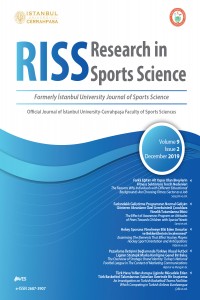Pazarlama İletişimi Bağlamında Türkiye Ulusal Futbol Liginin Stratejik Marka Kimliğine Genel Bir Bakış
Abstract
DOI: 10.5152/rss.2019.0007
Marka kimliği algılamaları günümüz tüketicilerin zihnindeki konumlar açısından önem arz etmektedir. Spor pazarlamasındaki marka kimliği algılamaları yoğun tüketici ilgisi olan pazarlar açısından potansiyel taşımaktadır. Bu çalışmada Türkiye Ulusal Futbol Süper Ligi bağlamında marka kimliği algılamaları bağlam olarak belirlenmiş ve bu algılamaların çeşitli özelliklere göre farklılık göstermesini araştırmak hedeflenmiştir. Söz konusu çalışmada kolayda örneklem yöntemiyle veri toplanmış ve 121’i kadın 279’u erkek olmak üzere 400 katılımcıya ulaşılmıştır. Tarama modeli kullanılan araştırmada örneklem kitlesinde Fenerbahçe, Beşiktaş, Galatasaray ve Trabzonspor taraftarları yer almaktadır. Verilerin analizinde faktör analizi, ANOVA ve t-testleri kullanılmış olup, öncelikle Türkiye Ulusal Futbol Süper Ligi’ndeki marka kimliği boyutları olarak dürüst-yetenekli, coşku ve seçkin boyutlarına ulaşılmıştır. Farklılıklar bağlamında demografik özelliklerden yaş grupları ve gelir grupları açısından istatistiksel olarak anlamlı sonuçları elde edilmiştir. Çalışma bulguları marka kimliği ve spor pazarlaması açısından teorik açıdan güncel bir bağlam ele almakla beraber, sektörel bilgi açısından yol gösterici özellik taşımaktadır.
Cite this article as: Akpınar HM, Mungan Ay S. The Overview of Strategic Brand Identity: Turkey’s National Footbal League in The Context of Marketing Communications. Research in Sports Science 2019; 9(2); 40-4.
Keywords
Pazarlama iletişimi marka kimliği marka kişiliği spor pazarlaması türkiye ulusal futbol süper ligi
References
- Aaker, D. (1996). Building Strong Brands. California: Simon and Schuster. Aaker, D. A. (1996). Measuring Brand Equity Across Products and Markets. California Management Review 38(3), 102-120. Azoulay, A., & Kapferer, J.-N. (2003). Do Brand Personality Scales Really Measure Brand Personality? Journal of Brand Management 11(2), 143-155. Bozkurt, H., & Kartal, R. (2008). Spor Pazarlamasında Halkla İlişkiler Ve Sponsorluk İlişkisi. Beden Eğitimi ve Spor Bilimleri Dergisi 2(1), 23-33. Fournier, S. (1998). Consumers and Their Brands: Developing Relationship Theory in Consumer Research. Journal of Consumer Research 24(4), 343-373. Gündoğdu, C., & Devecioğlu, S. (2008). Spor Hizmetlerinin Genel Ekonomi Çerçevesi Görünümü. Doğu Anadolu Bölgesi Araştırmaları, 117-124. Rajagopal. (2006). Impact of Advertising Variability on Building Costomer-Based Brand Personality in a Competitive Environment: Empirical Analysis with Reference to Mexico. Latin American Business Review 6(3), 63-84. Thompson, A. B. (2003). Brand Positioning And Brand Creation . London: Profile Books. Trout, J., & Ries, A. (1981). Positioning: The Battle For Your Mind. New York: McGraw-Hill. Vukasovic, T. (2011). Conceptual Model of Strategic Positioning of a Poultry Brand. World’s Poultry Science Journal 67(4), 643-652. Yurtkoru, S., Çinko, M., & Durmuş, B. (2013). Sosyal Bilimlerde SPSS’le Veri Analizi. Ankara: Beta Yayınları.
The Overview of Strategic Brand Identity: Turkey’s National Footbal League in The Context of Marketing Communications
Abstract
DOI: 10.5152/rss.2019.0007
Brand identity perceptions are important in the minds of today’s consumers. Brand identity perceptions in sports marketing have potential for markets with intense consumer interest. Brand identities related to Turkey’s National Football Super League are selected as context for this study and it is aimed to investigate whether the perceptions differ according to the various aspects of this perception. Convenience sampling technique is used with 400 participiants (121 female/279 male) employed for this study. Participants are supporters of Beşiktaş, Fenerbahçe, Galatasaray and Trabzonspor teams. For data analysis, factor analysis, ANOVA and t-tests are used. It was found that brand identities related to Turkey’s National Football Super League are honest-talented, enthusiasm and outstanding. In terms of differences, statistically significant results were obtained from demographic characteristics in terms of age groups and income groups. Besides the findings of the study have a theoretical context in terms of brand identity and sports marketing, it also provides guidance in terms of sectoral knowledge.
Cite this article as: Akpınar HM, Mungan Ay S. The Overview of Strategic Brand Identity: Turkey’s National Footbal League in The Context of Marketing Communications. Research in Sports Science 2019; 9(2); 40-4.
Keywords
Marketing communication brand ıdentity brand personality sports marketing national football turkey super league
References
- Aaker, D. (1996). Building Strong Brands. California: Simon and Schuster. Aaker, D. A. (1996). Measuring Brand Equity Across Products and Markets. California Management Review 38(3), 102-120. Azoulay, A., & Kapferer, J.-N. (2003). Do Brand Personality Scales Really Measure Brand Personality? Journal of Brand Management 11(2), 143-155. Bozkurt, H., & Kartal, R. (2008). Spor Pazarlamasında Halkla İlişkiler Ve Sponsorluk İlişkisi. Beden Eğitimi ve Spor Bilimleri Dergisi 2(1), 23-33. Fournier, S. (1998). Consumers and Their Brands: Developing Relationship Theory in Consumer Research. Journal of Consumer Research 24(4), 343-373. Gündoğdu, C., & Devecioğlu, S. (2008). Spor Hizmetlerinin Genel Ekonomi Çerçevesi Görünümü. Doğu Anadolu Bölgesi Araştırmaları, 117-124. Rajagopal. (2006). Impact of Advertising Variability on Building Costomer-Based Brand Personality in a Competitive Environment: Empirical Analysis with Reference to Mexico. Latin American Business Review 6(3), 63-84. Thompson, A. B. (2003). Brand Positioning And Brand Creation . London: Profile Books. Trout, J., & Ries, A. (1981). Positioning: The Battle For Your Mind. New York: McGraw-Hill. Vukasovic, T. (2011). Conceptual Model of Strategic Positioning of a Poultry Brand. World’s Poultry Science Journal 67(4), 643-652. Yurtkoru, S., Çinko, M., & Durmuş, B. (2013). Sosyal Bilimlerde SPSS’le Veri Analizi. Ankara: Beta Yayınları.
Details
| Primary Language | English |
|---|---|
| Subjects | Sports Medicine |
| Journal Section | Original Article |
| Authors | |
| Publication Date | December 1, 2019 |
| Published in Issue | Year 2019 Volume: 9 Issue: 2 |

